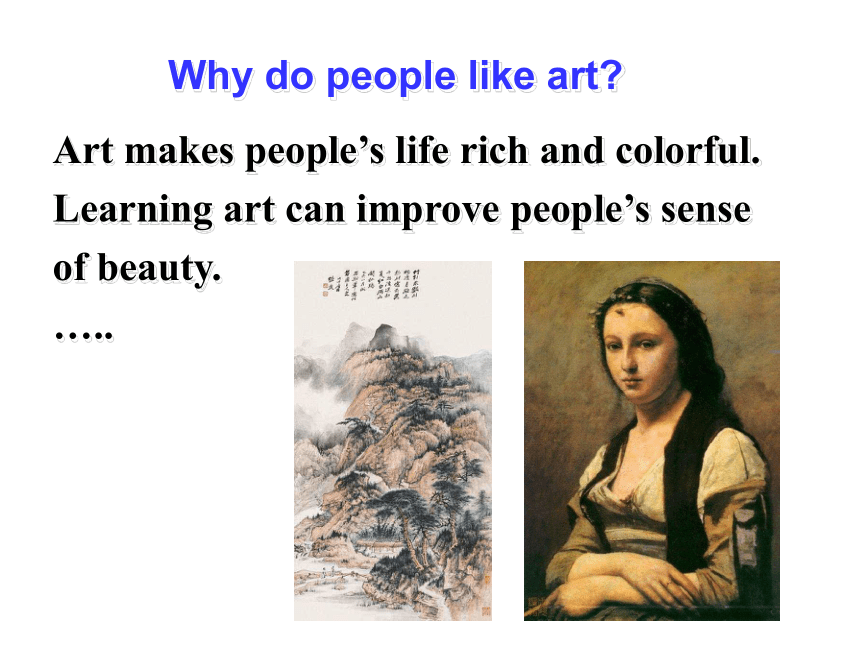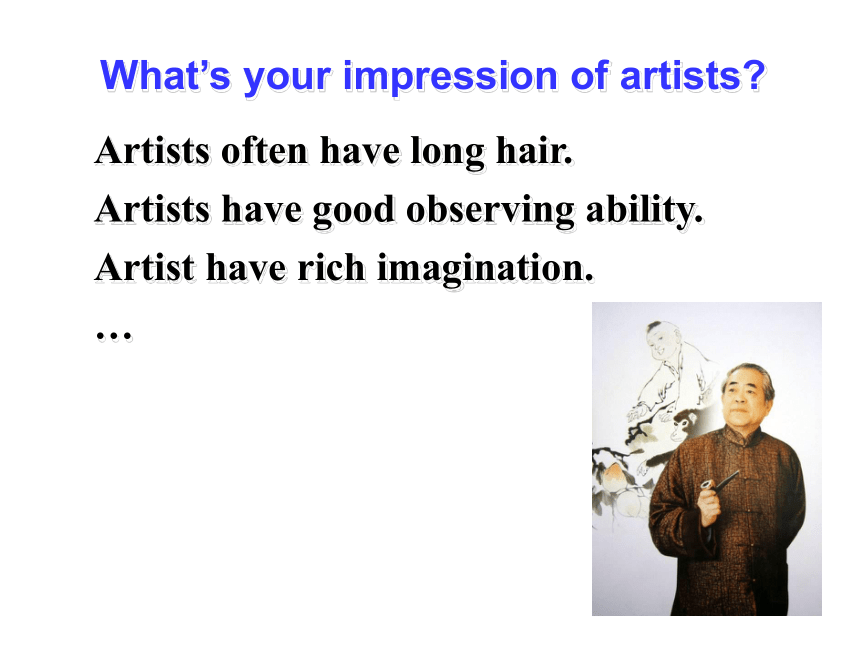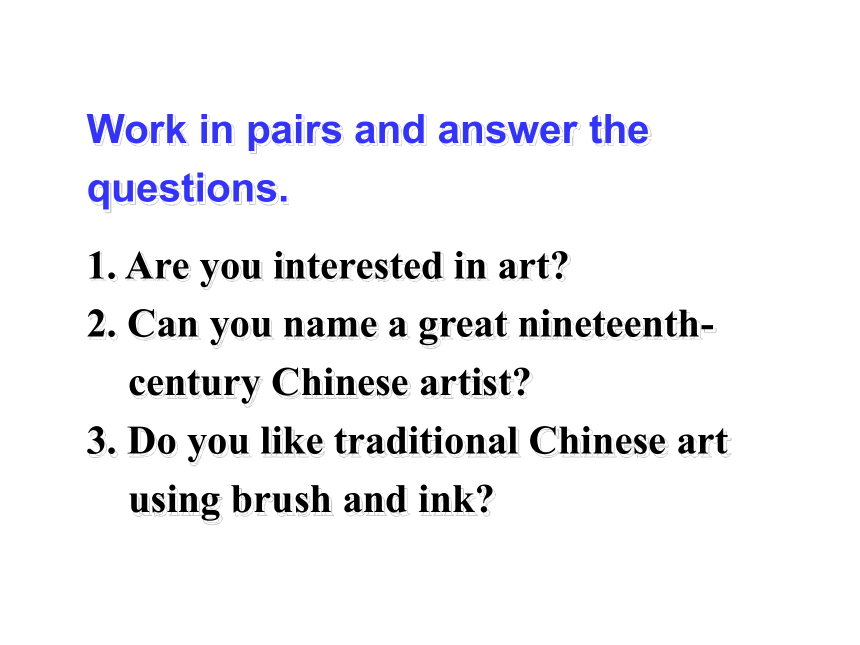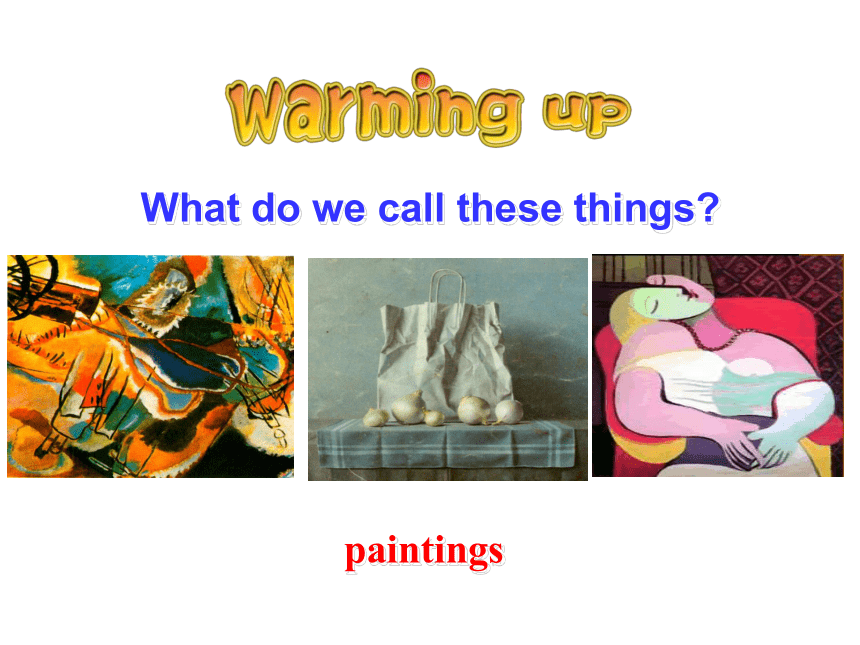外研版高一英语必修二 Module 4 Fine Arts — Western Chinese and Pop Arts Reading and vocabulary 课件(共86张PPT)
文档属性
| 名称 | 外研版高一英语必修二 Module 4 Fine Arts — Western Chinese and Pop Arts Reading and vocabulary 课件(共86张PPT) |  | |
| 格式 | zip | ||
| 文件大小 | 5.0MB | ||
| 资源类型 | 教案 | ||
| 版本资源 | 外研版 | ||
| 科目 | 英语 | ||
| 更新时间 | 2019-01-21 10:20:44 | ||
图片预览












文档简介
课件86张PPT。 外研版
高一年级 (必修2) Module 4
Fine Arts — Western,
Chinese and Pop ArtsIntroductionTo learn the descriptions with paintings
To talk about some world-class artists and their styles
To learn some useful words and
expressions in the passageArt is long.
Good painting is like good cooking, it can be tasted, but not explained.Why do people like art?Art makes people’s life rich and colorful.
Learning art can improve people’s sense of beauty.
…..What’s your impression of artists?Artists often have long hair.
Artists have good observing ability.
Artist have rich imagination.
…Work in pairs and answer the questions. 1. Are you interested in art?
2. Can you name a great nineteenth-century Chinese artist?
3. Do you like traditional Chinese art using brush and ink?artist art gallery brush colourful contemporary delightful draw drawing ink paint painter painting scene traditionalUse these words to help you.Look at the paintings. Say which one you prefer.
Give it a title.
Write two or three sentences saying
what you think about it.How many kinds of arts are there?painting
design
sculpturewatercolor
oil painting
cartoonadvertisement
clothes
buildingwoodcut
stone carvingWhat do we call these things? paintingsIf you could have three of these paintings on the walls for your rooms, which would you choose? Tell your reasons.Look at the paintings. Discuss in groups:Do you know any famous painters in the world?
What do you know about them and their works?He’s and Italian Painter.
He lived during the 15th and 16th century.
He’s well know for his works like Mona Lisa and The Last Supper.Lenonardo da VinciMona Lisa and The Last Supper.Zhang?Daqian?(1899—1983) was one of the best-known Chinese artists?of the twentieth century. Zhang DaqianCan you match the painting and the painters? Xu BeihongWho are your favorite painters in China?Qi BaishiZhang DaqianReading and vocabularyMatch these words and phrases with the definitions.alive aspect imitate (art) movement observe ordinary reality style1. the way in which something is done
2. to watch carefully
3. a style of painting adopted by a group of artists styleobserve movement4. to copy
5. living or full of life
6. not special or unusual
7. one of the separate parts of something
8. the way something really is aspect imitate alive ordinary reality alive aspect imitate (art) movement observe ordinary reality styleRead passages A – F, then:1. Match paintings 1 – 4 with
descriptions in paragraphs A – D.
2. Say which paintings are
mentioned in paragraphs E and F.→ D →C Paintings ( ) are mentioned in paragraphs E and paintings ( ) in paragraphs F.1, 4 2, 3 4 → A → B Read paragraphs A-F again and choose the correct answer. 1. The Cubist art movement _____.
A. showed different sides of an object in the same picture
B. is considered to be the greatest art movement of the twentieth centuryA2. Pop art ______.
A. advertised the twentieth-century life
B. tried to show ordinary life in the modern world
3. Qi Baishi ______.
A. painted in a very unusual way
B. was a very traditional Chinese artistBB4. Xu Beihong ______.
A. wanted to do more than imitate reality
B. tried to paint horses
5. Wu Hang _____ the picture of a
golden-haired girl.
A. loves B. dislikesAB6. Sarah Hardwick thinks that ____.
A. a Chinese artist painted picture 3
B. Pablo Picasso painted picture 3ARead paragraphs A-D and the 4 paintings, then fill in the blanks in the table. Cubismordinarydifferentsoup cansblack inksshrimpsXu Beihong?lifeRead paragraphs E and F and fill in the blanks in the chart. Qi Baishisix horsesPicassoPainters
1. Picasso ?
2. Lichtenstein
3. Qi Baishi
4. Xu BeihongMatch the painters with their information.?Information?
A. contemporary American artist
B. famous for his lively paintings of horses
C. the greatest western artist of the 20th century
D. observing the world of nature very carefully1-C 2-A 3-D 4-B1. Cubist painters
2. Pop artists
3. Chinese paintings 4. Xu Beihong
5. Wu Hang
6. Sarah HardwickA. use black inks and natural colours
B. show the real life of people in cities
C. stressed showing reality
D. show objects and people from different angles at the same time.
E. is interested in both Chinese and western paintings
F. does not like pop artMatch the two parts of the sentences.1-D 2-B 3-A
4-C 5-F 6-EDecide whether the following
statements are true (T) or false (F).
1. There was no cubist artist before Picasso and Braque.?? (???? )
2. Pop art aimed to reflect something unusual in the cities. ?????? ??(???? )
3. Qi Baishi's paintings are different from others' because he observed everything carefully. (??? )TFT4. Xu Beihong believed that artists should imitate life a lot. ???? ??(???? )
5. Wu Hang does not like art school because he is tired of looking at pictures. ?????????????? (???? )
6. Sarah Hardwick is interested in art because she was influenced by her parents.? ???????? (???? )FFTThis is a _________ by the Spanish ______, Pablo Picasso, considered to be the ________ western artist of the twentieth century. Picasso and another _______, George Braque, started ________, one of the most important of all modern ___ _________. Cubist artists painted _______ &_______, with different _______ of the object or person ________ at the same time.Close the books and complete the blanks.paintingartistgreatestpainterCubismart movementobjectspeopleaspectsshowingThis painting is by _____________ American ______ Roy Lichtenstein who is a world _______ example of ____ _____. Pop art was an important _______ ____ _________ that aimed to show _________ twentieth-century ______ _____. For example, it ______ things ______ ____ soup cans and advertisements.contemporaryartistfamouspop artmodern art movementordinarycity lifeshowssuch asQi Baishi, one of China’s ________ _______, followed the _________ Chinese style of painting. Chinese painting is ______ for its brush __________ in black ______ and nature ________. Qi Baishi __________ the world of nature very __________, and his paintings are ________ because of this.greatest painterstraditionalknowndrawingsinkscoloursobservedcarefullyspecial Xu Beihong was one of China’s
__________ twentieth-century ________. Like Qi Baishi, Xu painted in the __________ Chinese style. Both painters have a beautiful ______ _____. Xu Beihong believed that _______ should show _______, but not just _______ it. Instead, a picture should try to show the _______ of its subject. He is most _______ for his lively paintings of _________.best-knownartiststraditionalbrush lineartistsrealityimitate“life”famoushorses1. This is a painting by the Spanish artist,
Pablo Picasso, considered to be the greatest western artist of the twentieth century.
这是西班牙画家巴勃罗·毕加索的一幅油画; 他被认为是二十世纪西方最伟大的艺术家。consider
(1) vt. & vi. “仔细考虑; 思考”作此意讲时, 其后的动词需用ing形式。e.g. Many students in our school are
considering studying abroad. 我们学校很多学生在考虑去国外学习。We considered where to get enough water. 我们考虑到哪儿去弄足够的水。
Consider carefully before you decide.
要仔细考虑后再做决定。
Considering the strength of their team, we did very well to score two goals.
考虑到他们队的实力, 我们进两球就不错了。(2) consider vt. “认为;把……看作”
常用搭配:consider sb./sth. (as/to be) + adj./n.将某人/某物视为……e.g. I always consider you (to be/as) my best friend.
我总是把你看作我最好的朋友。
He considered Founder laptops (to be) very good.
他认为方正笔记本电脑很好。【拓展】
considerable adj. 相当的; 可观的
considerably adv. 非常地
considering prep. 考虑到
considered adj. 经过考虑的
consideration n. 考虑;体谅
take sth./sb. into consideration
考虑某人/事反馈练习1) We all consider Mr. Liu _____ an
excellent teacher in our school. Which
of the following is wrong?
A. / B. to be C. as D. for
2) Tom said he was considering __ his job.
A. changing B. to change
C. of changing D. being changed DA2. Cubist artists painted objects and people, with different aspects of the object or person showing at the same time.
在描绘物体或人的时候,立体派画家
同时展现对象的多个不同侧面。 with复合结构由“with + 宾语 + 宾语补足语”构成,宾语补足语可以是名词、形容词、介词短语、副词、动词-ing形式(表主动进行)、动词-ed形式(表被动完成)、动词不定式(表将来)等。这种结构常在句中用作状语,表示伴随情况或行为方式等。e.g. With many forests being destroyed,
many species of plants and animals
are dying out.
随着许多森林被破坏, 许多种动植物
都渐渐灭绝了。
Don’t sleep with the door and
windows open.
不要开着门窗睡觉。反馈练习
1) You have no idea how she finished the relay race _____ her foot wounded so much.
A. for B. when C. with D. while
选C。with her foot wounded是with复合结构作伴随状语。2) John received an invitation to dinner, and with his work _____, he gladly accepted it.
A. finished B. finishing
C. having finished D. was finished
选A。his work和finish之间是被动关系,故用动词-ed形式作宾补。3. He is most famous for his lively paintings of horses. 他以擅长画生机勃勃的马而著称。(1) “most + 形容词或副词”结构前不用冠词, 或有不定冠词a时, 不表示最高级, 而表示“非常”, 相当于very。e.g. The lady is most experienced in
taking care of children.
那位女士在照顾小孩方面很有经验。(2) lively adj. 活泼的; 生动的; 栩栩如生
的; 强烈的
e.g. She’s is a lively child and popular
with everyone.
她是活泼的孩子, 大家都很喜欢她。Our teacher gave us a lively description of the event.
老师将那件事给我们做了生动的描述。
The subject produced a lively discussion in our class.
那个话题在我们班引发了激烈的讨论。反馈练习 英译汉
1) I received a most unusual gift from my uncle. ________________________________
_______
2) He can draw a lively cat in five minutes. _______________________________ _______我从叔叔那了收到了一份非常特别的
礼物。他能在五分钟内画出一只栩栩如生的猫。get/be/feel tired of 对……感到厌烦;厌倦
get/be/feel tired from因……感到疲劳 4. I’m studying art at school, and I enjoy it a lot, although I can get tired of looking at pictures all the time.
我在学校学习艺术, 我很开心, 虽然
总是看图可能会看腻。e.g. I’m tired of watching TV; let’s go out for a walk.
我看腻了电视,让我们出去走走吧。
I’m very tired from walking such a
long way.
走了这么长的路后,我感到很疲劳。反馈练习1) 我讨厌听他的演讲。
____________________2) 他因长时间踢球而感到疲劳。
________________________________
________________I’m tired of his speech. He felt tired from playing football for a long time. 5. But I can’t stand that picture of a golden-haired girl.
但我受不了那幅金发女孩儿的画。
stand作动词,本句中意为“忍受”,stand还有“站起来;站着;位于;高达;承受”等含义,后面可接名词或动词的-ing形式。e.g. At the end of the concert, the audience stood and clapped.
音乐会结束时,观众起立鼓掌。
The school stands on the hill.
这所学校坐落在小山上。
The building stands 100 metres high.
这座楼高达一百米。
Fruit trees cannot stand the cold.
果树不耐寒。1) I can’t stand _____ with Jane in the same office. She just refuses _____ talking while she works.
A. working; stopping B. to work; stopping
C. working; to stop D. to work; to stop反馈练习选C。stand doing sth. 容忍做某事;refuse to do sth. 拒绝做某事。句意:我不能容忍和珍妮在一个办公室工作,她工作时总是喋喋不休。2) Modern plastics can _____ very high and very low temperatures.
A. stand B. hold C. carry D. support
选A。stand承受;hold拿;carry携带;support支持。根据语境可知A项正确。1) He can’t stand life without the Internet. _______________________________
2) I think my decision can stand the
test of time. _______________________________他无法忍受没有网络的生活。我想我的决定经得起时间的考验。英译汉6. My parents are fond of going to art galleries and often take me with them, so I’ve developed an interest in art. 我的父母很喜欢去美术馆, 常带我一 起去, 我由此对艺术产生了兴趣。(1) be fond of 喜欢
e.g. The child is fond of playing the
piano.
这个孩子喜欢弹钢琴。(2) develop an interest in…
对……产生兴趣e.g. She has developed an interest in collecting stamps.
她对集邮感兴趣。7. They look so alive. 他们看起来如此逼真。
alive adj. 活着的; 有活力的; 现存的; 栩栩如生的; 充满……的(常与with 连用); 注意到的(与to连用)e.g. Many people think he is the greatest
artist alive today.
很多人认为他是现今在世的最伟大
的艺术家。It was a very bad accident. They are lucky to be alive.
那是一场很严重的事故, 他们能活下来很幸运。
The granny is still very much alive, even more alive than many young people.
那位老奶奶很有活力, 甚至比很多年轻人都活跃。1. live(1) 作形容词时, 表示“活着的”, 通常用于修饰动物, 只能置于名词前作定语, 此时与living通用。
e.g. We were so excited to see real
live (living) elephants.
看到真实的大象, 我们很激动。同义辨析live / living / alive(2) (节目等) 现场直播的e.g. I’m listening to a live phone-in radio show. 我正在收听phone-in节目的现场直播.
There will be live TV coverage of tonight’s big match. 今晚的重大赛事有现场直播。2. living living表示“活着的”, 可用于修饰人或
物。living things为固定搭配, 表示“所
有生物”。
e.g. He’s one of the greatest living composers.
他是在世的最伟大的作曲家之一。
The sun affects all living things.
太阳影响一切生物。3. alive表示“活着” 时, 含有“虽有死的可能, 但
还活着”的意思; 其作定语时必须后置。
e.g. I’m the happiest person alive. 我是世上最快乐的人。
The doctors are working hard to keep him alive.
医生们正在努力维持他的生命。反馈练习1) People found him still _____ after the road accident, so they sent him to hospital at once.
A. alive B. living C. to live D. lively
2) Millions of people watched the ___TV broadcast of the football match.
A. living B. alive C. live D. livelyACSentence Explanations1. This is a painting by the Spanish artist, Pablo Picasso, considered to be the greatest western artist of the twentieth century.
【分析】
① 本句是一个简单句。
②句子的主干是“主语(This)+系动词(is)+表语(__________)”结构。a painting③by the Spanish artist是介词短语作后置定语,修饰painting;Pablo Picasso是Spanish artist的同位语。
④ considered to be ... century是动词-ed形式作后置定语,修饰Pablo Picasso。
【句意】这是西班牙画家巴勃罗·毕加索的一幅油画,他被认为是20世纪西方最伟大的画家。 【仿写】这是网络作家杰克的一篇文章,他被认为是最受欢迎的网络作家之一。
_________________________________
_________________________________
_________________________________This is an essay by the Internet writer, Jack, considered to be one of the most popular Internet writers.2. My parents are fond of going to art galleries and often take me with them, so I’ve developed an interest in art. ?
【分析】
①本句是一个由so连接的并列句。
②so前的分句中are fond of和______并列作谓语。take【句意】我父母喜欢去美术馆,他们常常
带我一起去,我由此对艺术产生了兴趣。
【仿写】 我父母喜欢去音乐会,他们常
常带我一起去,我由此对音乐产生了兴
趣。
___________________________________
___________________________________
___________________________________My parents are fond of going to concert and often take me with them, so I’ve developed an interest in music. ?1. be interested in
2. give it a title?????
3. think about????
4. full of life??
5. be considered to be the greatest western artist of the twentieth century??
6. different aspects of the object or person???
7. at the same time?8. pop art?
9. aim to show ordinary twentieth-century city life
10. for example
11. such as??????????
12. the traditional Chinese style of painting?
13. be known as??
14. be most famous for his lively paintings of horses?15. get tired of???????
16. be crazy about?
17. such a lovely example of his work?
18. be fond of going to art galleries
19. develop an interest in art???
20. tell by the styleI.?根据下面各句句意以及所给单词的首字母或汉语提示词,写出该单词的正确形式(每空一词)。
1. A good hotel manager should know his guests' likes and d________.
2. There was a large ________ (绘画) of his father on the wall.
3. I like modern pop music, while my mother likes t__________ music.dislikes?painting?traditional4. Hopefully, we can make history come ________ (有生气的) for the children.
5. Have you thought about the problem from every a________?
6. It is interesting to ________ (观察) the reaction of the children to these changes.
7. The doctor had to a________ a new method to treat this disease.alive?aspectobserveadoptII.?用适当的介词填空。
1. Babies soon begin to take an interest ________ the world around them.
2. This question is not easy to answer, so you have to think ________ it very carefully.
3. Lucy was a happy child, always full ________ life.inaboutof?4. The new teacher came into the classroom, ________ a book under her arm.
5. We had grown fond ________ the house and didn't want to leave.
6. The two shirts are of the same colour but different ________ style.withof?inIII.?根据括号内的汉语提示补全下面句子(每空一词)。
1. John ______ ___ ____ _____ _______ (意欲赢得第一名) in the race and kept practising every day.
2. I ____ _____ ___ (对……厌烦) all her negative opinions.
3. If you _____ ______ (难忍) the heat, get out of the kitchen.aimed to win first place?get tired of?can’t stand?4. My younger brother __ ______ ______ ________ (痴迷于象棋) and plays it almost every day.
5. It's important to ________________ _______ ______ _______(养成健康的生活习惯) during our childhood.
6. It must have been painted by Qi Baishi; I can ____ ___ ___ _____? (从绘画风格看出来).is crazy aboutdevelop / formtell by its stylechess?healthy living habits?1. Read the text again and pick out the
sentences you appreciate.
2. Remember the words and phrases we
have learned.
3. Find more information about the
artists mentioned in the text.
高一年级 (必修2) Module 4
Fine Arts — Western,
Chinese and Pop ArtsIntroductionTo learn the descriptions with paintings
To talk about some world-class artists and their styles
To learn some useful words and
expressions in the passageArt is long.
Good painting is like good cooking, it can be tasted, but not explained.Why do people like art?Art makes people’s life rich and colorful.
Learning art can improve people’s sense of beauty.
…..What’s your impression of artists?Artists often have long hair.
Artists have good observing ability.
Artist have rich imagination.
…Work in pairs and answer the questions. 1. Are you interested in art?
2. Can you name a great nineteenth-century Chinese artist?
3. Do you like traditional Chinese art using brush and ink?artist art gallery brush colourful contemporary delightful draw drawing ink paint painter painting scene traditionalUse these words to help you.Look at the paintings. Say which one you prefer.
Give it a title.
Write two or three sentences saying
what you think about it.How many kinds of arts are there?painting
design
sculpturewatercolor
oil painting
cartoonadvertisement
clothes
buildingwoodcut
stone carvingWhat do we call these things? paintingsIf you could have three of these paintings on the walls for your rooms, which would you choose? Tell your reasons.Look at the paintings. Discuss in groups:Do you know any famous painters in the world?
What do you know about them and their works?He’s and Italian Painter.
He lived during the 15th and 16th century.
He’s well know for his works like Mona Lisa and The Last Supper.Lenonardo da VinciMona Lisa and The Last Supper.Zhang?Daqian?(1899—1983) was one of the best-known Chinese artists?of the twentieth century. Zhang DaqianCan you match the painting and the painters? Xu BeihongWho are your favorite painters in China?Qi BaishiZhang DaqianReading and vocabularyMatch these words and phrases with the definitions.alive aspect imitate (art) movement observe ordinary reality style1. the way in which something is done
2. to watch carefully
3. a style of painting adopted by a group of artists styleobserve movement4. to copy
5. living or full of life
6. not special or unusual
7. one of the separate parts of something
8. the way something really is aspect imitate alive ordinary reality alive aspect imitate (art) movement observe ordinary reality styleRead passages A – F, then:1. Match paintings 1 – 4 with
descriptions in paragraphs A – D.
2. Say which paintings are
mentioned in paragraphs E and F.→ D →C Paintings ( ) are mentioned in paragraphs E and paintings ( ) in paragraphs F.1, 4 2, 3 4 → A → B Read paragraphs A-F again and choose the correct answer. 1. The Cubist art movement _____.
A. showed different sides of an object in the same picture
B. is considered to be the greatest art movement of the twentieth centuryA2. Pop art ______.
A. advertised the twentieth-century life
B. tried to show ordinary life in the modern world
3. Qi Baishi ______.
A. painted in a very unusual way
B. was a very traditional Chinese artistBB4. Xu Beihong ______.
A. wanted to do more than imitate reality
B. tried to paint horses
5. Wu Hang _____ the picture of a
golden-haired girl.
A. loves B. dislikesAB6. Sarah Hardwick thinks that ____.
A. a Chinese artist painted picture 3
B. Pablo Picasso painted picture 3ARead paragraphs A-D and the 4 paintings, then fill in the blanks in the table. Cubismordinarydifferentsoup cansblack inksshrimpsXu Beihong?lifeRead paragraphs E and F and fill in the blanks in the chart. Qi Baishisix horsesPicassoPainters
1. Picasso ?
2. Lichtenstein
3. Qi Baishi
4. Xu BeihongMatch the painters with their information.?Information?
A. contemporary American artist
B. famous for his lively paintings of horses
C. the greatest western artist of the 20th century
D. observing the world of nature very carefully1-C 2-A 3-D 4-B1. Cubist painters
2. Pop artists
3. Chinese paintings 4. Xu Beihong
5. Wu Hang
6. Sarah HardwickA. use black inks and natural colours
B. show the real life of people in cities
C. stressed showing reality
D. show objects and people from different angles at the same time.
E. is interested in both Chinese and western paintings
F. does not like pop artMatch the two parts of the sentences.1-D 2-B 3-A
4-C 5-F 6-EDecide whether the following
statements are true (T) or false (F).
1. There was no cubist artist before Picasso and Braque.?? (???? )
2. Pop art aimed to reflect something unusual in the cities. ?????? ??(???? )
3. Qi Baishi's paintings are different from others' because he observed everything carefully. (??? )TFT4. Xu Beihong believed that artists should imitate life a lot. ???? ??(???? )
5. Wu Hang does not like art school because he is tired of looking at pictures. ?????????????? (???? )
6. Sarah Hardwick is interested in art because she was influenced by her parents.? ???????? (???? )FFTThis is a _________ by the Spanish ______, Pablo Picasso, considered to be the ________ western artist of the twentieth century. Picasso and another _______, George Braque, started ________, one of the most important of all modern ___ _________. Cubist artists painted _______ &_______, with different _______ of the object or person ________ at the same time.Close the books and complete the blanks.paintingartistgreatestpainterCubismart movementobjectspeopleaspectsshowingThis painting is by _____________ American ______ Roy Lichtenstein who is a world _______ example of ____ _____. Pop art was an important _______ ____ _________ that aimed to show _________ twentieth-century ______ _____. For example, it ______ things ______ ____ soup cans and advertisements.contemporaryartistfamouspop artmodern art movementordinarycity lifeshowssuch asQi Baishi, one of China’s ________ _______, followed the _________ Chinese style of painting. Chinese painting is ______ for its brush __________ in black ______ and nature ________. Qi Baishi __________ the world of nature very __________, and his paintings are ________ because of this.greatest painterstraditionalknowndrawingsinkscoloursobservedcarefullyspecial Xu Beihong was one of China’s
__________ twentieth-century ________. Like Qi Baishi, Xu painted in the __________ Chinese style. Both painters have a beautiful ______ _____. Xu Beihong believed that _______ should show _______, but not just _______ it. Instead, a picture should try to show the _______ of its subject. He is most _______ for his lively paintings of _________.best-knownartiststraditionalbrush lineartistsrealityimitate“life”famoushorses1. This is a painting by the Spanish artist,
Pablo Picasso, considered to be the greatest western artist of the twentieth century.
这是西班牙画家巴勃罗·毕加索的一幅油画; 他被认为是二十世纪西方最伟大的艺术家。consider
(1) vt. & vi. “仔细考虑; 思考”作此意讲时, 其后的动词需用ing形式。e.g. Many students in our school are
considering studying abroad. 我们学校很多学生在考虑去国外学习。We considered where to get enough water. 我们考虑到哪儿去弄足够的水。
Consider carefully before you decide.
要仔细考虑后再做决定。
Considering the strength of their team, we did very well to score two goals.
考虑到他们队的实力, 我们进两球就不错了。(2) consider vt. “认为;把……看作”
常用搭配:consider sb./sth. (as/to be) + adj./n.将某人/某物视为……e.g. I always consider you (to be/as) my best friend.
我总是把你看作我最好的朋友。
He considered Founder laptops (to be) very good.
他认为方正笔记本电脑很好。【拓展】
considerable adj. 相当的; 可观的
considerably adv. 非常地
considering prep. 考虑到
considered adj. 经过考虑的
consideration n. 考虑;体谅
take sth./sb. into consideration
考虑某人/事反馈练习1) We all consider Mr. Liu _____ an
excellent teacher in our school. Which
of the following is wrong?
A. / B. to be C. as D. for
2) Tom said he was considering __ his job.
A. changing B. to change
C. of changing D. being changed DA2. Cubist artists painted objects and people, with different aspects of the object or person showing at the same time.
在描绘物体或人的时候,立体派画家
同时展现对象的多个不同侧面。 with复合结构由“with + 宾语 + 宾语补足语”构成,宾语补足语可以是名词、形容词、介词短语、副词、动词-ing形式(表主动进行)、动词-ed形式(表被动完成)、动词不定式(表将来)等。这种结构常在句中用作状语,表示伴随情况或行为方式等。e.g. With many forests being destroyed,
many species of plants and animals
are dying out.
随着许多森林被破坏, 许多种动植物
都渐渐灭绝了。
Don’t sleep with the door and
windows open.
不要开着门窗睡觉。反馈练习
1) You have no idea how she finished the relay race _____ her foot wounded so much.
A. for B. when C. with D. while
选C。with her foot wounded是with复合结构作伴随状语。2) John received an invitation to dinner, and with his work _____, he gladly accepted it.
A. finished B. finishing
C. having finished D. was finished
选A。his work和finish之间是被动关系,故用动词-ed形式作宾补。3. He is most famous for his lively paintings of horses. 他以擅长画生机勃勃的马而著称。(1) “most + 形容词或副词”结构前不用冠词, 或有不定冠词a时, 不表示最高级, 而表示“非常”, 相当于very。e.g. The lady is most experienced in
taking care of children.
那位女士在照顾小孩方面很有经验。(2) lively adj. 活泼的; 生动的; 栩栩如生
的; 强烈的
e.g. She’s is a lively child and popular
with everyone.
她是活泼的孩子, 大家都很喜欢她。Our teacher gave us a lively description of the event.
老师将那件事给我们做了生动的描述。
The subject produced a lively discussion in our class.
那个话题在我们班引发了激烈的讨论。反馈练习 英译汉
1) I received a most unusual gift from my uncle. ________________________________
_______
2) He can draw a lively cat in five minutes. _______________________________ _______我从叔叔那了收到了一份非常特别的
礼物。他能在五分钟内画出一只栩栩如生的猫。get/be/feel tired of 对……感到厌烦;厌倦
get/be/feel tired from因……感到疲劳 4. I’m studying art at school, and I enjoy it a lot, although I can get tired of looking at pictures all the time.
我在学校学习艺术, 我很开心, 虽然
总是看图可能会看腻。e.g. I’m tired of watching TV; let’s go out for a walk.
我看腻了电视,让我们出去走走吧。
I’m very tired from walking such a
long way.
走了这么长的路后,我感到很疲劳。反馈练习1) 我讨厌听他的演讲。
____________________2) 他因长时间踢球而感到疲劳。
________________________________
________________I’m tired of his speech. He felt tired from playing football for a long time. 5. But I can’t stand that picture of a golden-haired girl.
但我受不了那幅金发女孩儿的画。
stand作动词,本句中意为“忍受”,stand还有“站起来;站着;位于;高达;承受”等含义,后面可接名词或动词的-ing形式。e.g. At the end of the concert, the audience stood and clapped.
音乐会结束时,观众起立鼓掌。
The school stands on the hill.
这所学校坐落在小山上。
The building stands 100 metres high.
这座楼高达一百米。
Fruit trees cannot stand the cold.
果树不耐寒。1) I can’t stand _____ with Jane in the same office. She just refuses _____ talking while she works.
A. working; stopping B. to work; stopping
C. working; to stop D. to work; to stop反馈练习选C。stand doing sth. 容忍做某事;refuse to do sth. 拒绝做某事。句意:我不能容忍和珍妮在一个办公室工作,她工作时总是喋喋不休。2) Modern plastics can _____ very high and very low temperatures.
A. stand B. hold C. carry D. support
选A。stand承受;hold拿;carry携带;support支持。根据语境可知A项正确。1) He can’t stand life without the Internet. _______________________________
2) I think my decision can stand the
test of time. _______________________________他无法忍受没有网络的生活。我想我的决定经得起时间的考验。英译汉6. My parents are fond of going to art galleries and often take me with them, so I’ve developed an interest in art. 我的父母很喜欢去美术馆, 常带我一 起去, 我由此对艺术产生了兴趣。(1) be fond of 喜欢
e.g. The child is fond of playing the
piano.
这个孩子喜欢弹钢琴。(2) develop an interest in…
对……产生兴趣e.g. She has developed an interest in collecting stamps.
她对集邮感兴趣。7. They look so alive. 他们看起来如此逼真。
alive adj. 活着的; 有活力的; 现存的; 栩栩如生的; 充满……的(常与with 连用); 注意到的(与to连用)e.g. Many people think he is the greatest
artist alive today.
很多人认为他是现今在世的最伟大
的艺术家。It was a very bad accident. They are lucky to be alive.
那是一场很严重的事故, 他们能活下来很幸运。
The granny is still very much alive, even more alive than many young people.
那位老奶奶很有活力, 甚至比很多年轻人都活跃。1. live(1) 作形容词时, 表示“活着的”, 通常用于修饰动物, 只能置于名词前作定语, 此时与living通用。
e.g. We were so excited to see real
live (living) elephants.
看到真实的大象, 我们很激动。同义辨析live / living / alive(2) (节目等) 现场直播的e.g. I’m listening to a live phone-in radio show. 我正在收听phone-in节目的现场直播.
There will be live TV coverage of tonight’s big match. 今晚的重大赛事有现场直播。2. living living表示“活着的”, 可用于修饰人或
物。living things为固定搭配, 表示“所
有生物”。
e.g. He’s one of the greatest living composers.
他是在世的最伟大的作曲家之一。
The sun affects all living things.
太阳影响一切生物。3. alive表示“活着” 时, 含有“虽有死的可能, 但
还活着”的意思; 其作定语时必须后置。
e.g. I’m the happiest person alive. 我是世上最快乐的人。
The doctors are working hard to keep him alive.
医生们正在努力维持他的生命。反馈练习1) People found him still _____ after the road accident, so they sent him to hospital at once.
A. alive B. living C. to live D. lively
2) Millions of people watched the ___TV broadcast of the football match.
A. living B. alive C. live D. livelyACSentence Explanations1. This is a painting by the Spanish artist, Pablo Picasso, considered to be the greatest western artist of the twentieth century.
【分析】
① 本句是一个简单句。
②句子的主干是“主语(This)+系动词(is)+表语(__________)”结构。a painting③by the Spanish artist是介词短语作后置定语,修饰painting;Pablo Picasso是Spanish artist的同位语。
④ considered to be ... century是动词-ed形式作后置定语,修饰Pablo Picasso。
【句意】这是西班牙画家巴勃罗·毕加索的一幅油画,他被认为是20世纪西方最伟大的画家。 【仿写】这是网络作家杰克的一篇文章,他被认为是最受欢迎的网络作家之一。
_________________________________
_________________________________
_________________________________This is an essay by the Internet writer, Jack, considered to be one of the most popular Internet writers.2. My parents are fond of going to art galleries and often take me with them, so I’ve developed an interest in art. ?
【分析】
①本句是一个由so连接的并列句。
②so前的分句中are fond of和______并列作谓语。take【句意】我父母喜欢去美术馆,他们常常
带我一起去,我由此对艺术产生了兴趣。
【仿写】 我父母喜欢去音乐会,他们常
常带我一起去,我由此对音乐产生了兴
趣。
___________________________________
___________________________________
___________________________________My parents are fond of going to concert and often take me with them, so I’ve developed an interest in music. ?1. be interested in
2. give it a title?????
3. think about????
4. full of life??
5. be considered to be the greatest western artist of the twentieth century??
6. different aspects of the object or person???
7. at the same time?8. pop art?
9. aim to show ordinary twentieth-century city life
10. for example
11. such as??????????
12. the traditional Chinese style of painting?
13. be known as??
14. be most famous for his lively paintings of horses?15. get tired of???????
16. be crazy about?
17. such a lovely example of his work?
18. be fond of going to art galleries
19. develop an interest in art???
20. tell by the styleI.?根据下面各句句意以及所给单词的首字母或汉语提示词,写出该单词的正确形式(每空一词)。
1. A good hotel manager should know his guests' likes and d________.
2. There was a large ________ (绘画) of his father on the wall.
3. I like modern pop music, while my mother likes t__________ music.dislikes?painting?traditional4. Hopefully, we can make history come ________ (有生气的) for the children.
5. Have you thought about the problem from every a________?
6. It is interesting to ________ (观察) the reaction of the children to these changes.
7. The doctor had to a________ a new method to treat this disease.alive?aspectobserveadoptII.?用适当的介词填空。
1. Babies soon begin to take an interest ________ the world around them.
2. This question is not easy to answer, so you have to think ________ it very carefully.
3. Lucy was a happy child, always full ________ life.inaboutof?4. The new teacher came into the classroom, ________ a book under her arm.
5. We had grown fond ________ the house and didn't want to leave.
6. The two shirts are of the same colour but different ________ style.withof?inIII.?根据括号内的汉语提示补全下面句子(每空一词)。
1. John ______ ___ ____ _____ _______ (意欲赢得第一名) in the race and kept practising every day.
2. I ____ _____ ___ (对……厌烦) all her negative opinions.
3. If you _____ ______ (难忍) the heat, get out of the kitchen.aimed to win first place?get tired of?can’t stand?4. My younger brother __ ______ ______ ________ (痴迷于象棋) and plays it almost every day.
5. It's important to ________________ _______ ______ _______(养成健康的生活习惯) during our childhood.
6. It must have been painted by Qi Baishi; I can ____ ___ ___ _____? (从绘画风格看出来).is crazy aboutdevelop / formtell by its stylechess?healthy living habits?1. Read the text again and pick out the
sentences you appreciate.
2. Remember the words and phrases we
have learned.
3. Find more information about the
artists mentioned in the text.
